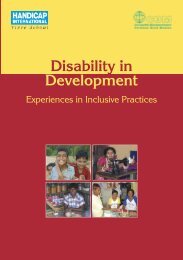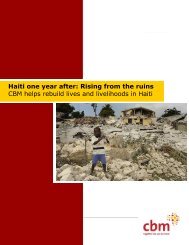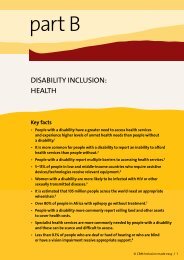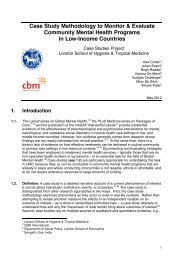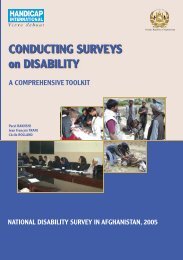Vision 2020 - World Health Organization
Vision 2020 - World Health Organization
Vision 2020 - World Health Organization
Create successful ePaper yourself
Turn your PDF publications into a flip-book with our unique Google optimized e-Paper software.
VISION <strong>2020</strong>: THE RIGHT TO SIGHT<br />
6.<br />
Delineate the various roles and responsibilities of all stakeholders.<br />
7. Perform a comprehensive situation and needs analysis, covering all existing eye-care services and<br />
eye-related health issues in a given population.<br />
8. Develop a VISION <strong>2020</strong> prevention of blindness national plan, which should be feasible and appropriate<br />
for the country.<br />
9. Implement the VISION <strong>2020</strong> prevention of blindness plan, by generating and using domestic<br />
resources rather then relying on external support from international nongovernmental development<br />
organizations.<br />
10. Establish monitoring systems to review progress.<br />
11. Assess and evaluate achievements periodically.<br />
Intensified support to selected countries<br />
The intention is to concentrate efforts to ensure progress towards implementing national VISION <strong>2020</strong><br />
plans in 26 countries identifi ed as requiring support. The selected countries are Armenia, Bangladesh,<br />
Cambodia, Djibouti, Dominica, Dominican Republic, Ethiopia, Fiji, Guatemala, Guyana, Indonesia,<br />
Jamaica, Madagascar, Mali, Morocco, Mozambique, Nigeria, Pakistan, Peru, Philippines, Republic of<br />
Moldova, United Republic of Tanzania, Yemen and selected districts or states of China, India and the<br />
Russian Federation.<br />
The intensifi ed assistance to these countries is not intended to impose limitations on other countries<br />
that are developing national VISION <strong>2020</strong> programmes. In the selected countries, two areas that require<br />
immediate attention are:<br />
• provision of technical support for formulating national plans and programmes for the prevention<br />
of blindness; and<br />
• improving coordination among the various stakeholders involved in implementation of national<br />
VISION <strong>2020</strong> programmes.<br />
Financial sustainability<br />
In order to make national VISION <strong>2020</strong> programmes sustainable, a number of fi nancing mechanisms<br />
can be considered:<br />
• Insurance schemes: Private or government health insurance schemes are increasingly available to<br />
help patients cover the cost of medical treatment; however, such schemes are still found predominantly<br />
in middle- and high-income countries, and most poor population groups still have limited or<br />
no coverage. In many instances, such insurance schemes cover only government employees and<br />
persons with remunerated posts.<br />
• Government subsidies: Governments have limited and often decreasing resources for eye health<br />
care. Additionally, prevention of blindness is usually not seen as a priority, despite the evidence<br />
that restoration or preservation of sight is a cost-effective health intervention. Governments should<br />
be made aware of the benefi ts of preventing and curing blindness.<br />
• Cost recovery from patients: Patients with suffi cient income can be asked to pay for services, and<br />
the revenue can be used to subsidize services for patients with low income, who could not otherwise<br />
afford treatment. This model has been used successfully in some Asian countries (e.g. India and<br />
57






